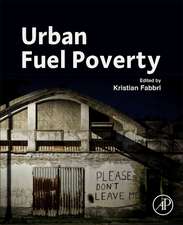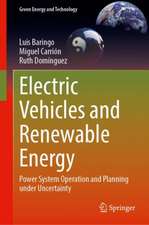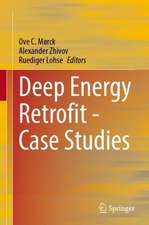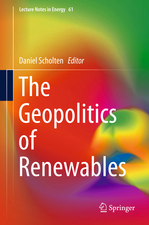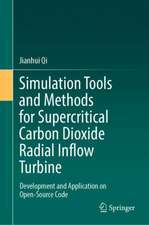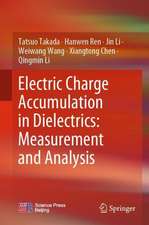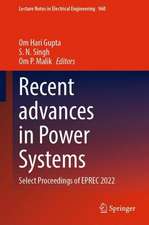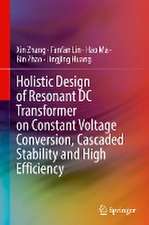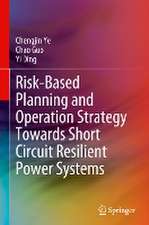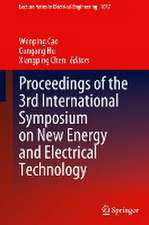Indoor Thermal Comfort Perception: A Questionnaire Approach Focusing on Children
Autor Kristian Fabbrien Limba Engleză Hardback – 10 iul 2015
The research field of indoor thermal comfort adopts, on the one hand, physical parameter measurements and comfort indexes (e.g. Predicted Mean Vote (PMV) or adaptive comfort), and on the other, an ergonomic assessment in the form of questionnaires. However the latter can offer only limited insights into the issue of comfort, as children often use different terms than adults to convey their experience of thermal comfort. The books aims to address this lack of understanding with regard to children’s perceptions of indoor thermal comfort.
The book is intended for HVAC engineers and researchers, architects and researchers interested in thermal comfort and the built environment. It also provides a useful resource for environmental psychologists, medical and cognitive researchers.
| Toate formatele și edițiile | Preț | Express |
|---|---|---|
| Paperback (1) | 371.26 lei 38-44 zile | |
| Springer International Publishing – 15 oct 2016 | 371.26 lei 38-44 zile | |
| Hardback (1) | 384.60 lei 38-44 zile | |
| Springer International Publishing – 10 iul 2015 | 384.60 lei 38-44 zile |
Preț: 384.60 lei
Nou
Puncte Express: 577
Preț estimativ în valută:
73.60€ • 76.56$ • 60.76£
73.60€ • 76.56$ • 60.76£
Carte tipărită la comandă
Livrare economică 08-14 aprilie
Preluare comenzi: 021 569.72.76
Specificații
ISBN-13: 9783319186504
ISBN-10: 3319186507
Pagini: 120
Ilustrații: XI, 302 p. 99 illus., 47 illus. in color.
Dimensiuni: 155 x 235 x 22 mm
Greutate: 0.62 kg
Ediția:2015
Editura: Springer International Publishing
Colecția Springer
Locul publicării:Cham, Switzerland
ISBN-10: 3319186507
Pagini: 120
Ilustrații: XI, 302 p. 99 illus., 47 illus. in color.
Dimensiuni: 155 x 235 x 22 mm
Greutate: 0.62 kg
Ediția:2015
Editura: Springer International Publishing
Colecția Springer
Locul publicării:Cham, Switzerland
Public țintă
ResearchCuprins
Introduction.- A brief history of thermal comfort: from Effective Temperature to Adaptive Thermal Comfort.- Ergonomics of the thermal environment. Human Body and Clothes.- The indices of feeling – Predicted Mean Vote PMV and Percentage
People Dissatisfied PPD.- Assessment of the influence of the thermal environment using subjective judgement scales.- The Thermal Comfort and Child Development Psychology.- Field research.- Kindergarten Case Study.- Elementary School case study.- Middle School case study.- Conclusions.
People Dissatisfied PPD.- Assessment of the influence of the thermal environment using subjective judgement scales.- The Thermal Comfort and Child Development Psychology.- Field research.- Kindergarten Case Study.- Elementary School case study.- Middle School case study.- Conclusions.
Notă biografică
Arch. Kristian Fabbri has worked as architect and consultant on building energy performance, indoor environmental quality, human behaviour, heritage and energy management. He collaborated with Emilia-Romagna Region (Public Bodies) and SMEs trade and professional training organizations. He is Adjunct Professor in Environmental Physics Technique and Building Simulation, with the Architecture Department at University of Bologna. He has conducted research and issued publications in the same fields.
Textul de pe ultima copertă
Providing a methodology for evaluating indoor thermal comfort with a focus on children, this book presents an in-depth examination of children’s perceptions of comfort. Divided into two sections, it first presents a history of thermal comfort, the human body and environmental parameters, common thermal comfort indexes, and guidelines for creating questionnaires to assess children’s perceptions of indoor thermal comfort. It then describes their understanding of the concepts of comfort and energy, and the factors that influence that perception. In this context, it takes into account the psychological and pedagogical aspects of thermal comfort judgment, as well as architectural and environmental characteristics, and equips readers with the knowledge needed to effectively investigate children’s perspectives on environmental ergonomics.
The research field of indoor thermal comfort adopts, on the one hand, physical parameter measurements and comfort indexes (e.g. Predicted Mean Vote (PMV) or adaptive comfort), and on the other, an ergonomic assessment in the form of questionnaires. However the latter can offer only limited insights into the issue of comfort, as children often use different terms than adults to convey their experience of thermal comfort. The books aims to address this lack of understanding with regard to children’s perceptions of indoor thermal comfort.
The book is intended for HVAC engineers and researchers, architects and researchers interested in thermal comfort and the built environment. It also provides a useful resource for environmental psychologists, medical and cognitive researchers.
psychological and pedagogical aspects of thermal comfort judgment, as well as architectural and environmental characteristics, and equips readers with the knowledge needed to effectively investigate children’s perspectives on environmental ergonomics.
The research field of indoor thermal comfort adopts, on the one hand, physical parameter measurements and comfort indexes (e.g. Predicted Mean Vote (PMV) or adaptive comfort), and on the other, an ergonomic assessment in the form of questionnaires. However the latter can offer only limited insights into the issue of comfort, as children often use different terms than adults to convey their experience of thermal comfort. The books aims to address this lack of understanding with regard to children’s perceptions of indoor thermal comfort.
The book is intended for HVAC engineers and researchers, architects and researchers interested in thermal comfort and the built environment. It also provides a useful resource for environmental psychologists, medical and cognitive researchers.
The research field of indoor thermal comfort adopts, on the one hand, physical parameter measurements and comfort indexes (e.g. Predicted Mean Vote (PMV) or adaptive comfort), and on the other, an ergonomic assessment in the form of questionnaires. However the latter can offer only limited insights into the issue of comfort, as children often use different terms than adults to convey their experience of thermal comfort. The books aims to address this lack of understanding with regard to children’s perceptions of indoor thermal comfort.
The book is intended for HVAC engineers and researchers, architects and researchers interested in thermal comfort and the built environment. It also provides a useful resource for environmental psychologists, medical and cognitive researchers.
psychological and pedagogical aspects of thermal comfort judgment, as well as architectural and environmental characteristics, and equips readers with the knowledge needed to effectively investigate children’s perspectives on environmental ergonomics.
The research field of indoor thermal comfort adopts, on the one hand, physical parameter measurements and comfort indexes (e.g. Predicted Mean Vote (PMV) or adaptive comfort), and on the other, an ergonomic assessment in the form of questionnaires. However the latter can offer only limited insights into the issue of comfort, as children often use different terms than adults to convey their experience of thermal comfort. The books aims to address this lack of understanding with regard to children’s perceptions of indoor thermal comfort.
The book is intended for HVAC engineers and researchers, architects and researchers interested in thermal comfort and the built environment. It also provides a useful resource for environmental psychologists, medical and cognitive researchers.
Caracteristici
Presents an in-depth examination of children’s perceptions of indoor thermal comfort Provides guidelines for creating questionnaires to assess those perceptions Takes into account the psychological and pedagogical aspects of thermal comfort judgment Includes supplementary material: sn.pub/extras



